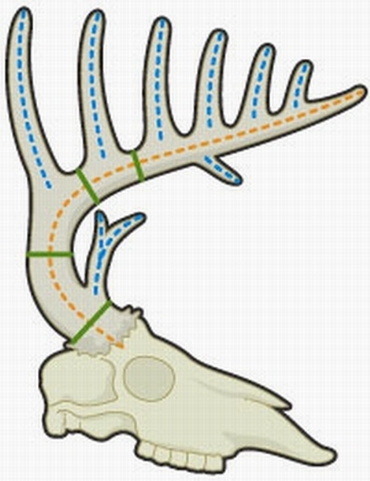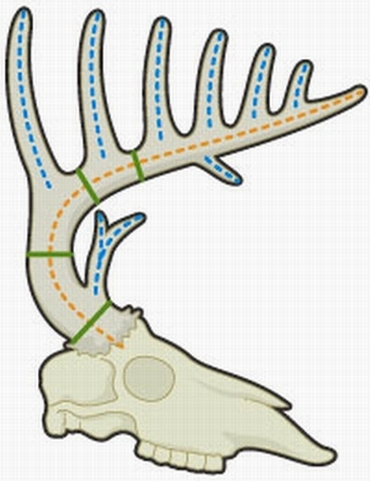Scoring your buck using the Boone & Crockett Method is not difficult, but it does require some time and effort. The biggest mistake most people make when scoring a whitetail’s antlers is inaccurately measuring the lengths of the points. To properly measure a point, you must first know the definition of a scorable point.
To determine how many normal and abnormal points your trophy has, the next step is to establish baselines so that “possible points” can be identified and all point lengths can be obtained. Determine the baseline at the base of each point along the main beam. To do this, dig into your scoring equipment and find your flexible steel cable.
Before we get into establishing baselines, remember that each point must be classified as either normal or abnormal. All normal points project from the top, not the sides or bottom, of the main beam and normal points may not branch from other points. The final point count for each antler includes all measurable points, normal and abnormal, plus remember the main beam tips.
Look at both sides of the rack and match up points by their location. Points that originate from the sides or bottoms of the main beams are obviously abnormal. If there are extra points along the tops of the main beams, such as between “normally” spaced points (compare to the other antler), this will create obvious mis-matches from the left side to the right side and these may be considered abnormal points (antlers with numerous abnormal points will most likely be scored as non-typical bucks).
With all of that said, let’s establish baselines. Hold the cable on top of the main beam about an inch from the point in question and run it around the point to the top of the main beam on the other side of the point. Holding the cable in place, you can see where the antler material from the main beam intersects material from the antler point. Using a pencil, draw a line below the cable.

You have now established the baseline for this point, but you must repeat this process in order to establish the baselines for every other point. With baselines established, use the flexible steel cable and measure from the tips of the points to their respective baselines.
Establishing the correct baseline is very important because you do not want to under-estimate point length, but you also don’t want to over-estimate. In addition, for small points, a proper baseline is important because it will allow you to determine whether or not the point meets the definition of a point. Also, keep in mind that you may have to repeat this process for abnormal points that occur on normal points. In this instance, repeat the baseline process but the point will serve as the “main beam” and the abnormal point will serve as the “point.”
On white-tailed deer antlers, all normal points project from the top, not the sides or bottom, of the main beam and they may not branch from other points. The final point count for each antler includes all measurable points, normal and abnormal, plus the main beam tip. Look at both sides of the rack and match up points by their location. If extra points along the beam tops create obvious mis-matches from side to side, these may be abnormal.



